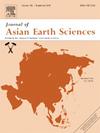磁化率的各向异性揭示了印度西北部马拉尼流纹岩的岩浆流动方向和侵位历史
IF 2.7
3区 地球科学
Q2 GEOSCIENCES, MULTIDISCIPLINARY
引用次数: 0
摘要
岩浆流动方向和岩浆位置可以提供有关岩浆活动的地球动力学和构造背景的重要细节。印度西北部马拉尼火成岩套是一个新元古代的大型硅质火成岩省。长英质(流纹岩)熔岩流和花岗质岩体在第一期喷发中占主导地位,基性熔岩和长英质、基性岩脉为次期喷发。马拉尼流纹岩的岩浆流动方向和侵位史尚不清楚。通过对马拉尼流纹岩的磁矿物学、显微观察和磁化率各向异性的研究,确定岩浆流动方向和侵位机制。钛磁铁矿和钛赤铁矿伪单畴是流纹岩的主要载体矿物。观察到长形、扁圆形和三轴磁椭球体,描述了就位期间与岩浆流动有关的正、中、逆结构。主磁化率轴呈三轴分布,呈良好的簇状分布,且不受形状因子T的影响,表明磁性线理和片理发育。在所有三个磁化率轴上,磁线化(K1)与微观流动指标最一致。AMS研究表明,磁性结构符合~ E-W向流动。磁线理的方位方向在所有地点都是一致的,代表了无可争议的~ E-W走向的流动意义;线的陡降是相互相反的,阻碍了一个明确的流动方向。AMS构造也显示出向下和向上的流动,可能与侧面和顶部的喷发有关。本文章由计算机程序翻译,如有差异,请以英文原文为准。

Anisotropy of magnetic susceptibility reveals the magma flow direction and emplacement history of Malani rhyolites, northwest India
Magma flow directions and emplacement may offer crucial details on the geodynamic and tectonic settings of magmatism. Malani Igneous Suite (MIS) in northwest India is a large silicic igneous province of the Neoproterozoic age. The eruption of MIS has been divided into three phases, with felsic (rhyolitic) lava flows and granitic plutons dominating the first phase and mafic lavas and felsic and mafic dykes acting as secondary components. The magma flow direction and emplacement history of Malani rhyolites are poorly understood. We study the magnetic mineralogy, microscopic observations, and anisotropy of magnetic susceptibility (AMS) of the Malani rhyolites to determine the magma flow directions and the emplacement mechanism. Ti-magnetite and Ti-hematite pseudo-single domains are the primary carrier minerals in the rhyolites. Prolate, oblate, and triaxial magnetic ellipsoid are observed and describe normal, intermediate, and inverse fabrics related to magma flow during emplacement. The principal susceptibility axes are well-clustered and independent of their shape factor (T) with a triaxial distribution, indicating well-developed magnetic lineation and foliation. In all three magnetic susceptibility axes, the magnetic lineation (K1) aligns finest with the microscopic flow indicators. AMS investigation shows that the magnetic fabric is consistent with an ∼ E-W trending flow. The azimuthal orientation of magnetic lineation is consistent in all the sites representing an undisputed ∼ E-W trending flow sense; the plunge of the lineation is mutually opposite, hindering an unambiguous flow direction. AMS fabrics also show downward and upward flow that could be related to flank and summit eruptions.
求助全文
通过发布文献求助,成功后即可免费获取论文全文。
去求助
来源期刊

Journal of Asian Earth Sciences
地学-地球科学综合
CiteScore
5.90
自引率
10.00%
发文量
324
审稿时长
71 days
期刊介绍:
Journal of Asian Earth Sciences has an open access mirror journal Journal of Asian Earth Sciences: X, sharing the same aims and scope, editorial team, submission system and rigorous peer review.
The Journal of Asian Earth Sciences is an international interdisciplinary journal devoted to all aspects of research related to the solid Earth Sciences of Asia. The Journal publishes high quality, peer-reviewed scientific papers on the regional geology, tectonics, geochemistry and geophysics of Asia. It will be devoted primarily to research papers but short communications relating to new developments of broad interest, reviews and book reviews will also be included. Papers must have international appeal and should present work of more than local significance.
The scope includes deep processes of the Asian continent and its adjacent oceans; seismology and earthquakes; orogeny, magmatism, metamorphism and volcanism; growth, deformation and destruction of the Asian crust; crust-mantle interaction; evolution of life (early life, biostratigraphy, biogeography and mass-extinction); fluids, fluxes and reservoirs of mineral and energy resources; surface processes (weathering, erosion, transport and deposition of sediments) and resulting geomorphology; and the response of the Earth to global climate change as viewed within the Asian continent and surrounding oceans.
 求助内容:
求助内容: 应助结果提醒方式:
应助结果提醒方式:


